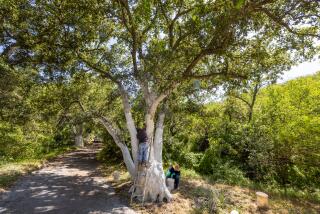Oak winter highflier
- Share via
[ HYDRIOMENA NUBILOFASCIATA ]
Walk into an oak grove in early spring and trigger a confetti of dusky white moths. Each insect lands just as suddenly as it takes off and -- cryptically patterned like a piece of lichen-encrusted bark -- instantly disappears. Part of a moth group known as geometers, the highflier larvae travel in a looping motion associated with their common name: inchworm. While feeding voraciously on the leaves of coast live oak and other oaks, these larvae assume the posture and color of buds. If startled, the caterpillars plummet from the canopy to the ground to escape capture. By flying in early spring, the 1-inch-long adults avoid predatory migrant songbirds that arrive a month later.
NATURAL HISTORY
Widespread from Mendocino to San Diego counties, these moths are considered one of the best insect indicators of spring as they gather in huge numbers among oaks or around lights at night.
KEY CHARACTERISTICS
Adults are a pale brownish gray, with darker, slightly greenish bands across their forewings.
More to Read
Sign up for The Wild
We’ll help you find the best places to hike, bike and run, as well as the perfect silent spots for meditation and yoga.
You may occasionally receive promotional content from the Los Angeles Times.





